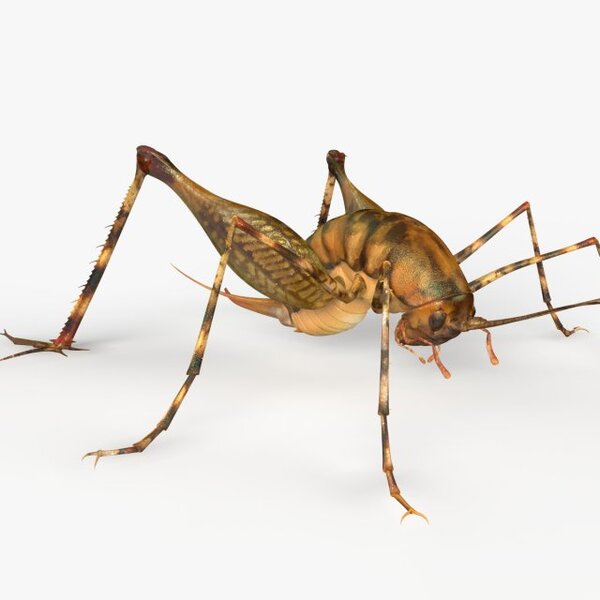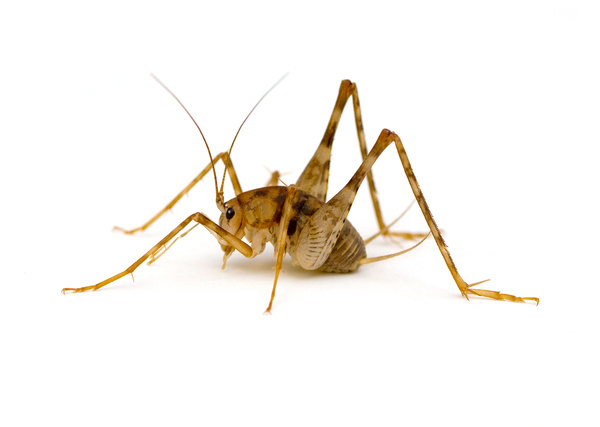Camelback crickets, often referred to as "house crickets" or "camel crickets", are unique insects that can be found in many homes, especially in damp or dark environments like basements, crawl spaces, or even garages. Despite their intimidating appearance, camelback crickets are harmless to humans and pets. In this article, we will delve into the characteristics, behavior, and ways to deal with these fascinating creatures.

Camelback crickets (scientific name: Ceuthophilus species) are a type of cricket known for their distinctive appearance. Unlike regular crickets, which are known for their chirping, camelback crickets are silent. They get their name from their arched, camel-like backs, which make them look a little unusual compared to other insects.
Size: Camelback crickets are fairly large, measuring about 1 to 2 inches in length, with long legs that help them jump high distances.
Color: They are usually a light brown or tan color, with darker markings on their bodies, especially along their backs.
Appearance: These crickets have long antennae, spiny legs, and large hind legs, which they use for jumping. Their curved back gives them the “camel” look, hence the name.
Camelback crickets are often found in dark, humid environments. These insects prefer places where moisture is high and light is scarce, making basements, crawl spaces, and bathrooms ideal places for them to live. They are especially attracted to areas where there is high humidity or where water has accumulated, such as:
Basements
Crawl spaces
Garages
Bathrooms
Attics (if they are damp)
They do not typically thrive in dry, well-lit areas, which is why they prefer the darker, more humid corners of your home.
Camelback crickets are omnivorous scavengers, meaning they will eat almost anything organic they can find. Their diet includes:
Decaying plant matter
Fungi
Other small insects or dead insects (they are opportunistic feeders)
Food scraps found around the house
If camelback crickets are in your home, it’s likely they are feeding on organic matter such as crumbs, mold, and other decaying materials. Although they may occasionally nibble on plant leaves or fabrics, they are not typically harmful to household items or plants.
Despite their creepy appearance, camelback crickets are not dangerous to humans or pets. They do not bite or sting and are not known to transmit diseases. However, some people may experience mild allergic reactions to their presence or droppings, particularly if they are allergic to insects in general. Their primary concern is that they can be a nuisance, especially if they invade your home in large numbers.
Camelback crickets are known for their hopping and jumping abilities. They are excellent jumpers and use their powerful hind legs to leap long distances when threatened. They can also climb walls and other surfaces, which is why they are often found in high places like attics or shelving units.
These crickets are night-active creatures, meaning they are most active during the nighttime, especially in low-light areas. During the day, they tend to hide in dark corners or crevices to avoid light.

Camel crickets, also known as camelback crickets, often jump at people when they feel threatened or startled. This behavior is a defensive reaction, rather than an aggressive one. Here's why this happens:
Camel crickets, like many other insects, are naturally shy and prefer to avoid confrontations. However, if they feel cornered or threatened, they will jump as a way to escape danger. Their powerful hind legs allow them to leap several feet in a single bound, and this sudden movement can make them appear as though they're jumping directly at you.
If you get too close to a camel cricket or disturb it in any way (for example, by walking by or shining a light on it), the cricket may jump out of instinct. This is a reaction to the sudden presence of a potential threat, like a human or a predator. It’s not aimed at attacking but rather an attempt to flee or avoid capture.
Camel crickets have poor vision and rely more on their sense of touch and vibrations to detect their surroundings. They are sensitive to movement, and when something suddenly approaches them, they might interpret it as a potential threat. Because they can't always accurately perceive what's in front of them, they sometimes leap in the direction of what they sense, which can appear as though they are jumping directly at you.
Some insects, including camel crickets, use jumping as a way to confuse or deter predators. By jumping in the air, they might disorient their would-be predator, making it harder for the predator to follow or catch them. When camel crickets feel like they are being threatened, jumping becomes an effective way for them to evade danger.
Sometimes, the cricket's jump is simply a reflex action. This means that in response to certain stimuli (like you moving quickly or approaching too close), their body may react instinctively, and they may leap in the direction they are facing, even if it ends up being directly at you.
While camel crickets jumping at you might be a bit unsettling, it's important to remember that they're not trying to harm you. Their jumping is a natural, defensive behavior that helps them escape threats. If you want to avoid startling them, try to move gently and quietly around areas where they live.
Camel crickets, also known as camelback crickets, do not bite humans. While their large, powerful hind legs and sharp mandibles might look intimidating, these crickets are non-aggressive and typically pose no danger to people or pets. However, they do have the ability to bite if they feel extremely threatened or if they are handled roughly. Here’s more information about camel crickets and their biting behavior:
Camel crickets are generally shy creatures and prefer to avoid confrontation. They are not aggressive and do not bite unless they are provoked. If they feel cornered or trapped, their first instinct is to flee, using their strong hind legs to jump away from danger.
Although camel crickets have mandibles (mouthparts), these are mainly used for feeding on plant material and decaying organic matter. Their mandibles are not designed for biting humans. The bite of a camel cricket, if it happens, is typically not painful. It might cause a slight irritation or discomfort, but it is not dangerous or venomous.
If you happen to handle a camel cricket (for example, by accidentally picking one up or touching it), it may bite in self-defense if it feels trapped or threatened. However, this is very rare, as these crickets are more likely to try and escape than to engage in biting behavior.
Even if a camel cricket does bite, the bite is usually harmless. Camel crickets do not carry diseases that are transmitted through bites. The primary concern with camel crickets is the nuisance they may cause when they invade homes in large numbers, particularly in damp and dark areas like basements or crawl spaces.
Biting is a defensive behavior, not an act of aggression. If a camel cricket feels cornered, handled roughly, or threatened, it may bite in an attempt to escape or defend itself. However, this behavior is extremely rare.
Camel crickets are generally harmless to humans and do not bite unless they feel extremely threatened. They are non-aggressive creatures that rely more on their ability to jump and evade danger than on biting. If you encounter a camel cricket, it’s best to let it be or carefully relocate it outside without handling it too much.

If you find camelback crickets in your home, here are some methods to control or get rid of them:
Seal Entry Points: The first step is to seal any cracks or holes in your home’s foundation, walls, or windows to prevent these insects from entering.
Reduce Humidity: Since camelback crickets thrive in moist conditions, consider using a dehumidifier or improving ventilation in damp areas like basements or crawl spaces.
Remove Food Sources: Clean up food scraps, crumbs, and decaying organic matter around your home. Store food in airtight containers to avoid attracting these insects.
Natural Repellents: You can use natural remedies like essential oils (e.g., eucalyptus or peppermint) or diatomaceous earth to repel camelback crickets.
Traps: Sticky traps can be used to capture camelback crickets and help reduce their numbers in your home.
If the infestation becomes too severe, you may want to contact a pest control professional to handle the situation.
Not True Crickets: While they are called crickets, camelback crickets belong to a different family called Gryllacrididae, which distinguishes them from the typical crickets known for their chirping sounds.
Surprisingly Resilient: Camelback crickets can survive in very harsh environments, which is why they can be so difficult to get rid of once they establish themselves in your home.
Role in Ecosystem: In nature, camelback crickets play an important role in breaking down organic matter, contributing to the ecosystem by recycling nutrients in the soil.
Camelback crickets are fascinating insects with unique physical features and behavior. Though they may seem intimidating due to their large size and “camel-like” appearance, they are harmless and not a direct threat to your health. However, if you find them invading your home, it's a good idea to take steps to control their population by reducing humidity, sealing entry points, and cleaning up organic matter. Understanding these crickets’ behavior and preferences can help you manage them effectively and keep your home free from unwanted pests.
animal tags: Camelback-Crickets
We created this article in conjunction with AI technology, then made sure it was fact-checked and edited by a Animals Top editor.